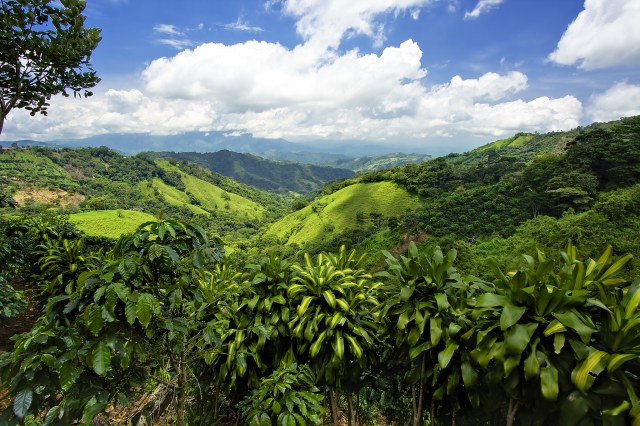When it comes to protecting the planet for future generations, we all have an important role to play – both at home and when vacationing.
We’ve reached a particularly fragile moment in the history of the Earth. The climate is rapidly changing and so too are critical ecosystems worldwide. By acting collectively, we can make a difference.
Need help getting started? Here are 24 sustainable travel tips to help you be more eco-friendly as you explore the world.
Become a slow traveler.
Slow travel has become a hot topic of conversation. For those not familiar with the concept, it’s the opposite of transportation-intensive itineraries that jam 10 countries into 12 days. Slow travel involves picking one or two destinations and staying put for longer, thus cutting down on carbon emissions. In other words, exploring one destination in more depth, truly getting to know its people, customs, traditions and landmarks, versus traveling to as many places as possible on a single vacation.
Similarly, aim to take fewer international or far-flung trips each year and when you engage in long-haul, carbon emissions-intensive journeys, plan to stay longer in your intended destination to make the trip worthwhile.
Choose climate-conscious travel companies, hotels and tour operators.
Do your homework when booking travel and research tour operators, travel companies and hotels carefully with an eye toward their sustainable business practices – or lack thereof.
Try to use your vacation dollars supporting travel businesses that are actively working to address the planet’s climate and environmental challenges. Often companies engaged in such important efforts are proud of what they’re doing and will make it clear on their websites and in their marketing materials.
Book flights responsibly.
The aviation industry is one of the most significant contributors to climate change. But you can help reduce the impact of flying by booking with airlines that have publicly committed to using sustainable aviation fuel, which is designed to reduce emissions. Some of the airlines taking this important step include United, Alaska, JetBlue, Southwest and Delta.
Purchase carbon offsets.
When you fly, take a cruise or drive, it results in carbon dioxide being released into the atmosphere, contributing to climate change. Cancel out some of those emissions by purchasing what’s known as offsets. This process involves providing financial support for projects around the world that are designed to reduce or store carbon emissions. Tree planting projects, for example, provide carbon offsetting.
One of the best-known and most reputable carbon offset companies is Tomorrow’s Air. It’s the first and only traveler collective that also provides climate education and helps fund carbon removal innovators.
Select non-stop flights.
It may seem like a small detail, but choosing nonstop flights, instead of connecting flights, is far better for the planet. “Nonstop flights produce remarkably fewer greenhouse gases,” says Nelly Gedeon, founder of Wayaj, a company that’s working to promote sustainable travel. “You not only reduce the impact by flying fewer total miles, but you eliminate additional takeoffs and landings that can account for nearly half of all carbon burned as a result of a flight.”
Minimize luggage weight on planes.
This might come as a surprise, but that suitcase you’re lugging around when traveling also plays a small role in contributing to emissions on planes. The heavier your suitcase, the greater the carbon emissions from the plane. That’s because an aircraft’s fuel consumption increases based on the weight of the plane. Packing light not only means your suitcase will be easier to carry during your vacation, but it will also be easier on the planet.
Get more tips for packing sustainably.
Travel shorter distances.
Longer flights, car rides and cruises result in a higher level of carbon emissions and have a greater impact on the planet. Consider local adventures, exploring your own city, state or region. Driving just a few hours generates far less emission than jetting around the world for all your vacations.
We love a good day trip!
Trains not planes.
When possible, travel by train, which is a cleaner form of transportation than flying. Trains have the lowest emissions per passenger mile.
“Train travel is an excellent alternative to flying,” says Gedeon. “Train operators are reinstating sleeper trains as travelers look to avoid air travel. And when on vacation, trains become part of the experience and it encourages us all to enjoy slow travel. When was the last time you gazed out the window watching the countryside go by?”
Contact a AAA travel advisor to learn about train travel options.
Walk and take public transportation.
Once you arrive at your destination, skip using a private car and instead try getting around by walking, cycling or using public transport, such as buses. Not only will this give you a chance to experience local life in your destination more authentically and potentially create even more memorable experiences from your journey, but it will also cut down on carbon emissions.
Use an electric or hybrid vehicle.
Planning a road trip? Use an electric or hybrid vehicle to reduce the emissions associated with your trip. Even if you don’t own an electric vehicle, you can still rent one for your trip. The infrastructure needed to make EV road trips easier has been increasing from coast to coast. Plan your next road trip with AAA’s EV website.
Rent an EV for your next trip with AAA.
Localize your experience.
Opting to support local communities through your choice of accommodations is another approach to sustainable travel – one that provides benefits for the planet and its people.
“As best as possible, choose locally owned accommodations, eat at restaurants that source ingredients from the local supply chain, use local tour guides and operators, and purchase handicrafts and goods from local artists and businesses,” says Alix Collins, director of marketing and communications for the global non-profit organization Center for Responsible Travel.
When you invest directly in rural, poor and economically marginalized communities, the hosts typically earn a fair income and you’re supporting the preservation of their cultural and environmental assets.
Support hotel sustainability initiatives.
Often when checking into a hotel or resort, you’ll notice signs and information around your guest room and the property itself outlining ways to reduce the impact of your stay.
“Most properties offer guests the opportunity to participate in their sustainability initiatives by placing in-room notices about water and electricity conservation, change of linens and towels, recycling trash, as well as replenishing drinking water,” says Gedeon. Do your part and engage in these efforts whether it’s taking shorter showers, reusing towels or participating in recycling programs.

Visit destinations that emphasize sustainability.
Many destinations are taking bold steps to rethink business as usual and integrate comprehensive sustainability initiatives. Yet another way to reduce your individual impact on the planet is by consciously choosing to visit destinations that put such approaches at the forefront of their operations.
“Research your destination and choose those that prioritize sustainable tourism and the natural balance of nature and humanity,” says Yank Moore, director of conservation for the Jekyll Island Authority.
Avoid Peak Travel Times.
Most people want to travel in the summer, leading to overcrowding and more garbage at popular destinations. The number of visitors to U.S. national parks, for example, has exploded over the past several years, straining the environment. Try to take vacations off-season to avoid crowds and lower the impact on the local environment.
Don’t support wildlife exploitation.
Activities like swimming with dolphins, riding elephants, taking selfies with tigers, and animal entertainment of any type, subject wild animals to a lifetime of captivity and cruelty.
A growing number of tour operators and travel providers are rejecting these unethical activities altogether, but not all have taken this important step. Do your part as a traveler and avoid these activities altogether, to help protect wildlife, especially endangered animals. Instead, consider visiting and supporting sanctuaries that do not involve riding, or engaging with the animals in a hands-on way.
Volunteer when visiting a destination.
Lounging at the beach is certainly relaxing, but you can also take an active part in helping to protect and regenerate the environment in places you’re visiting. Many destinations offer volunteer activities, even for tourists. This can include planting a tree, spending a few hours working at a sanctuary or taking part in a local beach cleanup.
Explore off-the-beaten paths.
Overtourism of popular destinations is a burden that degrades local environments, causes increased amounts of waste and depletes local resources. Opting to explore lesser-known destinations helps to reduce the impact on heavily trafficked places, while also supporting often overlooked communities that need your tourism dollars.
Don’t buy souvenirs made from illegal products.
Do not buy products made from animal parts. This includes tortoise shells or ivory, which involve the slaughter of wild – and often endangered – animals. At least 20,000 elephants are killed annually for their ivory. Items made with tortoise shell often involve killing endangered hawksbill sea turtles.
While you’re at it, avoid buying products made from coral, sea stars or shells. Coral is critical for the healthy survival of coral reefs and takes years to regenerate when harvested for souvenirs.
Bring reusables.
Single-use plastics, whether it’s a water bottle, plastic bag or plastic utensils, take as long as 1,000 years to break down. Plastics are causing damage to the environment worldwide.
Aim to replace your plastic items with more sustainable and eco-friendly products. This effort should expand beyond basic stainless steel water bottles to also address many of the other plastic items that are often part of one’s daily routine. Bring reusable cutlery to a destination, for instance, to avoid using plastic utensils while traveling. Travel with eco-friendly toothpaste tablets rather than traditional toothpaste tubes that are not compostable and do not break down easily in waste streams. Similarly, avoid bringing toiletries packaged in plastic on your journeys.
The marketplace for eco-friendly alternatives for personal use items is proliferating at the moment and finding better options just takes a few minutes of online research.

Use eco-friendly sunscreens.
A handful of destinations globally have begun banning sunscreens that contain chemicals harmful to coral reefs and marine life. When traveling to a beach destination, avoid using sunscreens with the ingredients oxybenzone and octinoxate, which contribute to the bleaching of coral reefs and are toxic for young coral. Instead, look for non-nano mineral options. Typically, eco-friendly sunscreens proclaim as much on packaging and will instead contain ingredients such as zinc oxide or titanium dioxide, which do not harm marine environments.
Eat a plant-based diet.
Plant-based foods generally have a much lower carbon footprint than animal-based foods and offer a major opportunity for mitigating climate change. Many tour operators are now featuring plant-based meals as are more than a few hotels and resorts around the world. Show these travel companies you support their efforts by not only traveling and staying with them but also by ordering the plant-based items on the menu.
Clean up trash as you explore.
As you go for hikes, bike rides or beach walks in a destination, be an active steward of the environment. Collect trash that you come across and bring it somewhere that it can be disposed of properly.
Support local artisans.
Avoid buying mass-produced souvenirs that are often made from plastic, produced in a factory and flown across the globe to be sold. Instead, buy from artists and producers in the destinations you’re visiting and locally run shops. “You will not only help the local community, but your friends and family may better appreciate the locally made souvenir,” says Gedeon.
Be a sustainable travel evangelist.
Tell your friends, coworkers and family members how easy it is to be a sustainable traveler. Be an evangelist for protecting the planet whenever you have the chance. Share tips about the ways you’ve chosen to mindfully explore the world, support locals, protect wildlife and reduce your impact on the climate.
AAA’s sustainable travel series is written in partnership with Kind Traveler, a women-and-veteran-owned sustainable travel platform empowering travelers to make a positive impact in local communities, and contributing writer, Mia Taylor.
Editor’s note: This article has been updated by AAA editors with additional material.
4 Thoughts on “24 Sustainable Travel Tips”
Leave A Comment
Comments are subject to moderation and may or may not be published at the editor’s discretion. Only comments that are relevant to the article and add value to the Your AAA community will be considered. Comments may be edited for clarity and length.















Thank you for your helpful suggestions. I choose to follow most, but not all of your suggestions, due to my physical capabilities and lifestyle choices. However, your list gives me an excellent launch pad from which to adjust my travel plans. Thank you!
What a load of BS! So, in your infinite wisdom you are encouraging readers to buy carbon offsets and become vegetarians? I think not. I have been with AAA for years but I will not listen to this radical, left -wing propaganda. I may be in the minority but I will seek an alternative to AAA.
Best advice for travel ever!!! Thanks for letting people know this important information.
Thanks so much. I follow most of these tips and will try and incorporate the rest of them in my future travel plans.
Excellent article, thank you!